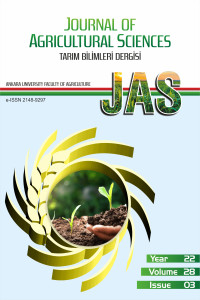Abstract
Supporting Institution
Ege Üniversitesi Bilisel Araştırma Projeleri Koordinasyon Birimi
Project Number
17 ZRF 032
Thanks
Bu projenin yürütülmesinde maddi olarak destek sağlayan Ege Üniversitesi Bilimsel Araştırma Projeleri Koordinasyon Birimine teşekkür ederiz.
References
- Referans 1: Ahlberg O, Gustafsson P & Wedel P (2006). Leaching of metals from sewage sludge during one year and their relation to particle size. Environmental Pollution 144:545-553.
- Referans 2: Bartlett R & James B (1979). Behavior of chromium in soils: III. Oxidation 1. J ournal of Environmental Quality 8 (1):31–35.
- Referans 3: Bremner J M & Mulvaney C S (1982). Nitrogen-total. In: Page AL, Miller RH, Keeney DR (editors). Methods of Soil Analysis: Part II. Chemical and Microbiological Properties. Madison, WI, USA: American Society of Agronomy, pp. 595-641.
- Referans 4: Cardossa‐Vigueros L & Ramirez‐Camperos E (2006). Tannery wastes and sewage sludge biodegradation by composting and vermicomposting process. Ingenieria Hidraulica En Mexico. 21(2):93-103.
- Referans 5: Delgado M, Bigeriego M, Walter I & Calbo R (1995). Use of California redworm in sewage sludge transformation. Turrialba. 45:33-41.
Abstract
The aim of this study is to investigate the stabilization of tannery sludge compost mixed with cattle manure at the different ratios by employing an epigeic earthworm Eisenia foetida and bioaccumulation of Cr in tannery sludge by earthworms. Organic cattle manure (M) and sludge compost (S) were mixed in certain proportions, moistened and Eisenia foetida worms were added. Mixing ratios were as follows: 100% M (M100S0), 70% M + 30% S (M70S30), 50% M + 50% S (M50S50) and 30% M + 70% S (M30S70). The experiment was carried out at a constant temperature of 24 oC and in a dark environment according to a randomized plot design with three replicates. The experiment ended after 120 days and the following parameters were evaluated in vermicomposts: pH, electrical conductivity (EC), total nitrogen (TN), total organic carbon (TOC), C:N ratio, and total macro and micro elements. In addition, it was determined total Cr, Cr (VI) in vermicomposts and total Cr in E. foetida body. The results for TOC, C:N ratio and total Cr showed decreases in their values at the end of the vermicomposting process, whereas values for pH, EC, TON, Ca, and Mg increase, indicating that the vermicomposting reached the maturity level. All values of Cr (VI) of vermicomposts were below the detectable level. During the vermicomposting process, the reduction rates of the total Cr amounts were 96% (M70S30), 96% (M50S50) and 30% (M30S70), respectively. While the highest total Cr amount in the earthworm body was determined in M30S70 treatment, the amount of this element in the earthworm body decreased due to the decreasing doses of tannery sludge compost. These results show that E. foetida can bioacumulate the chromium in tannery sludge compost. As a result, it was determined that vermicomposting can be an alternate technology for the recycling and environmentally safe disposal/management of tannery sludge compost using an epigeic earthworm E. foetida.
Project Number
17 ZRF 032
References
- Referans 1: Ahlberg O, Gustafsson P & Wedel P (2006). Leaching of metals from sewage sludge during one year and their relation to particle size. Environmental Pollution 144:545-553.
- Referans 2: Bartlett R & James B (1979). Behavior of chromium in soils: III. Oxidation 1. J ournal of Environmental Quality 8 (1):31–35.
- Referans 3: Bremner J M & Mulvaney C S (1982). Nitrogen-total. In: Page AL, Miller RH, Keeney DR (editors). Methods of Soil Analysis: Part II. Chemical and Microbiological Properties. Madison, WI, USA: American Society of Agronomy, pp. 595-641.
- Referans 4: Cardossa‐Vigueros L & Ramirez‐Camperos E (2006). Tannery wastes and sewage sludge biodegradation by composting and vermicomposting process. Ingenieria Hidraulica En Mexico. 21(2):93-103.
- Referans 5: Delgado M, Bigeriego M, Walter I & Calbo R (1995). Use of California redworm in sewage sludge transformation. Turrialba. 45:33-41.
Details
| Primary Language | English |
|---|---|
| Subjects | Engineering |
| Journal Section | Makaleler |
| Authors | |
| Project Number | 17 ZRF 032 |
| Publication Date | September 5, 2022 |
| Submission Date | April 10, 2021 |
| Acceptance Date | September 8, 2021 |
| Published in Issue | Year 2022 Volume: 28 Issue: 3 |
Cite
Journal of Agricultural Sciences is published as open access journal. All articles are published under the terms of the Creative Commons Attribution License (CC BY).


